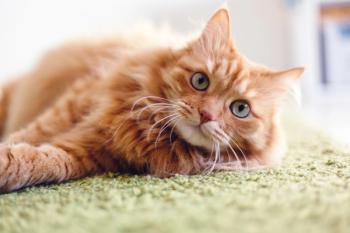
Research Updates: Giving glargine insulin to newly diagnosed diabetic cats may increase the likelihood of remission
This study's goal was to determine and compare the likelihood of remission in cats with newly diagnosed diabetes mellitus when treated with glargine insulin, protamine zinc insulin (PZI), or Lente insulin.
Diabetic remission, defined as reversion from a hyperglycemic to normoglycemic state in a diabetic patient after discontinuing insulin therapy, has been reported in cats that first present with uncomplicated diabetes mellitus or for treatment of diabetic ketoacidosis. Authors of previous studies have suggested that the success of glycemic control or the type of insulin being administered may affect the remission rate. This study's goal was to determine and compare the likelihood of remission in cats with newly diagnosed diabetes mellitus when treated with glargine insulin, protamine zinc insulin (PZI), or Lente insulin given subcutaneously twice a day.
Sara Wight/Getty Images
In this nonrandomized, prospective study, 24 cats in which diabetes mellitus had been diagnosed within the preceding 24 hours were enrolled. Initial assessment included performing a physical examination, serum chemistry profile, urinalysis, and urine bacterial culture. Each cat's fructosamine concentration was also determined. All cats with serious concurrent diseases were excluded from the study.
Erika Meler, DVM, MS
Enrolled patients included 21 cats with adequate food consumption and a lack of systemic signs that allowed immediate administration of one of the three subcutaneous insulins and three cats that required treatment with intravenous fluids and regular insulin before subcutaneous insulin administration could be started. Cats were distributed into the three insulin treatment groups with an attempt made to evenly match groups based on breed (Burmese vs. non-Burmese) and whether or not the cats had previously been given corticosteroids.
Barrak Pressler, DVM, PhD, DACVIM
The initial dose of subcutaneous insulin was between 0.25 and 0.5 IU/kg, as determined by the serum glucose concentration (< 360 mg/dl [< 20 mmol/L] vs. > 360 mg/dl, respectively). All cats were fed an identical ultra-low-carbohydrate-and-high-protein canned food (failure to eat this food was grounds for exclusion), and blood glucose curves were performed at regular intervals with the insulin dose adjusted by following a standard study-specific dosing chart. Diabetic remission was defined as having serum blood glucose concentrations within the reference range two weeks after discontinuing insulin administration.
In this study, by day 17, the cats receiving glargine insulin had a significantly lower mean daily blood glucose concentration than cats receiving either PZI or Lente insulin did. Consistent with this finding, cats receiving glargine insulin had significantly lower serum fructosamine concentrations at day 56 than did either of the other two treatment groups. The number of cats achieving diabetic remission was 100% (n=8) in the glargine insulin group vs. 38% (n=3) in the PZI group and 25% (n=2) in the Lente insulin group. Of the cats that had not achieved diabetic remission by day 17, those with lower mean 12-hour blood glucose concentrations (< 288 mg/dl [16 mmol/L]) were more likely to eventually achieve remission. Although some cats in the glargine insulin group developed hypoglycemia when treated according to the study's insulin dosing chart, none had clinical signs referable to this abnormality.
The likelihood of achieving diabetic remission was not associated with breed (Burmese vs. other breeds). Both of the cats that had previously received glucocorticoids achieved remission.
COMMENTARY
The results of this study support the hypothesis that when administered to newly diagnosed diabetic cats, glargine insulin results in a higher rate of short-term diabetic remission than do other insulin types. This study also demonstrated a higher rate of remission with glargine insulin than previously reported.1 Glargine insulin was administered in this study twice daily (vs. once daily as previously reported), which may explain this increased remission success but also allowed the authors to conclude that a dosage of 0.25 to 0.5 IU/kg twice a day is safe and efficient at attaining glycemic control.
Both in vitro and in vivo studies in diabetic cats and people have suggested that patients are unlikely to have lost function of all of their pancreatic beta cells at the time of first diagnosis of disease. Early and aggressive glycemic control may protect the remaining functional cells from continued glucotoxicity, may allow partial recovery from the unidentified insult that first resulted in diabetes mellitus, and may eventually allow reversion to a noninsulin-dependent (diabetic remission) state.
If this theory is true, however, any insulin regimen that results in strict glycemic regulation should produce the same results. The theoretical advantage of glargine insulin vs. other insulins commonly used in cats is its more consistent duration of action without producing a sharp nadir, thus allowing tighter control of serum glucose concentration and a minimal risk of clinically relevant hypoglycemia. Concurrent feeding of a diabetes-appropriate diet (low-carbohydrate content) prevents larger fluctuations in blood glucose concentration throughout the day and may further prevent glucotoxicity by minimizing beta cell burnout at times of higher insulin requirement.
Possible biases of this study include the nonrandomized allocation of cats into three treatment groups, the unintentional allocation of initially ketoacidotic patients into the nonglargine insulin groups, a relatively short monitoring period (112 days), and a less stringent definition of achieving remission than in other studies (two weeks without insulin vs. four weeks). Although cats that first present with diabetic ketoacidosis may also achieve diabetic remission, their rate of relapse (requiring insulin therapy again) may be greater than that of cats with uncomplicated diabetes.2
Longer follow-up is required before any statement can be made about the success rate of any insulin at producing permanent remission status.
Marshall RD, Rand JS, Morton JM. Treatment of newly diagnosed diabetic cats with glargine insulin improves glycaemic control and results in higher probability of remission than protamine zinc and lente insulins. J Feline Med Surg 2009;11(8):683-691.
The information in "Research Updates" was provided by Erika Meler, DVM, MS, and Barrak Pressler, DVM, PhD, DACVIM, Department of Veterinary Clinical Sciences, School of Veterinary Medicine, Purdue University, West Lafayette, IN 47907.
REFERENCES
1. Weaver KE, Rozanski EA, Mahony OM, et al. Use of glargine and Lente insulins in cats with diabetes mellitus. J Vet Intern Med 2006;20(2):234-238.
2. Sieber-Ruckstuhl NS, Kley S, Tschuor F, et al. Remission of diabetes mellitus in cats with diabetic ketoacidosis. J Vet Intern Med 2008;22(6):1326-1332.
Newsletter
From exam room tips to practice management insights, get trusted veterinary news delivered straight to your inbox—subscribe to dvm360.



